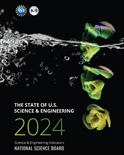News Release 12-011

New Report Outlines Trends in U.S. Global Competitiveness in Science and Technology
Asian countries are rapidly closing ranks on U.S. leadership

NSF launched a number of new initiatives to better position the United States in global S&E. (Credit and Larger Version)
January 17, 2012
The United States remains the global leader in supporting science and technology (S&T) research and development, but only by a slim margin that could soon be overtaken by rapidly increasing Asian investments in knowledge-intensive economies. So suggest trends released in a new report by the National Science Board (NSB), the policymaking body for the National Science Foundation (NSF), on the overall status of the science, engineering and technology workforce, education efforts and economic activity in the United States and abroad.
"This information clearly shows we must re-examine long-held assumptions about the global dominance of the American science and technology enterprise," said NSF Director Subra Suresh of the findings in the Science and Engineering Indicators 2012 released today. "And we must take seriously new strategies for education, workforce development and innovation in order for the United States to retain its international leadership position," he said.
Suresh oversees NSF's $7 billion dollar budget, which is awarded to the federal agency by Congress and funds basic research and education across all fields of science and engineering, including some 15 percent of federally supported basic research conducted at America's colleges and universities.
According to the new Indicators 2012, the largest global S&T gains occurred in the so-called "Asia-10"--China, India, Indonesia, Japan, Malaysia, Philippines, Singapore, South Korea, Taiwan and Thailand--as those countries integrate S&T into economic growth. Between 1999 and 2009, for example, the U.S. share of global research and development (R&D) dropped from 38 percent to 31 percent, whereas it grew from 24 percent to 35 percent in the Asia region during the same time.
In China alone, R&D growth increased a stunning 28 percent in a single year (2008-2009), propelling it past Japan and into second place behind the United States.
"Over the last decade, the world has changed dramatically," said José-Marie Griffiths, chair of the NSB committee that oversees production of the report. "It's now a world with very different actors who have made advancement in science and technology a top priority. And many of the troubling trends we're seeing are now very well established."
In 2009, President Obama released A Strategy for American Innovation, which recognized the importance of science and engineering as drivers of innovation and identified a strong fundamental research base as critical to innovation, economic growth and competitiveness.
"Maintaining our role as the world's engine of scientific discovery and technological innovation [is] absolutely essential to our future," the president said.
NSF has launched a number of new initiatives designed to better position the United States globally and at home by enhancing international collaborations, improving education and establishing new partnerships between NSF-supported researchers and those in industry, for example.
- Science Across Virtual Institutes (SAVI) fosters interaction among scientists, engineers and educators around the globe. Because S&T excellence exists in many parts of the world, scientific advances can be accelerated when scientists and engineers work together across international borders. The Wireless Innovation Between Finland and the United States, for instance, provides a platform for building long-term research and education collaborations between the U.S. and Finland-two world leaders in wireless technology-who have formed a virtual institute to study dynamic radio spectrum access. SAVI collaborations are also underway between U.S. teams and researchers in India, Brazil, France, Germany, Israel, Singapore and the United Kingdom.
- The NSF Innovation Corps (I-Corps) program, a public-private partnership, will connect NSF-funded scientific research with the technological, entrepreneurial and business communities to help create a stronger national ecosystem for innovation. NSF, the Deshpande Foundation, and the Kauffman Foundation are founding members along with a national network of advisors and partnering institutions. Technology developers, business leaders, venture capitalists and others from private industry will provide critical expertise to help transform scientific and engineering results into potentially successful technologies.
- NSF investment in advanced manufacturing holds great potential for significant short-term and long-term economic impact by promising entirely new classes and families of products that were previously unattainable, including emerging opportunities in cyber-physical systems, advanced robotics, nano-manufacturing, and sensor- and model-based smart manufacturing.
- Science, Engineering and Education for Sustainability, or (SEES), is a cross-disciplinary approach to sustainability science designed to spark innovations for tomorrow's clean energy. It will also improve our capabilities for rapid response to extreme events.
"NSF's support of fundamental research, which propels intellectual curiosity in every branch of science and engineering, and ignites the passion to uncover the inner workings of nature, is more precious now than ever before," Suresh said. "At the same time, scientific discoveries from fundamental research have their widest impact when they engender innovations, products and processes that transform society and help solve global challenges."
-NSF-
Related Websites
A Strategy for American Innovation: http://www.whitehouse.gov/innovation/strategy
NSF FY2012 budget request speech: http://www.nsf.gov/news/speeches/suresh/11/ss110214_nsfbudget.jsp
Science and Engineering Indicators 2012 (available at noon on Jan. 18): http://www.nsf.gov/statistics/indicators/
Useful NSB Web Sites:
Home Page: http://www.nsf.gov/nsb
Media Contact: http://www.nsf.gov/staff/staff_bio.jsp?lan=nlymn&org=NSF
News: http://www.nsf.gov/nsb/news
Meetings: http://www.nsf.gov/nsb/meetings
Publications: http://www.nsf.gov/nsb/publications
Facebook: https://www.facebook.com/NationalScienceBoard
Twitter: Twitter: https://twitter.com/intent/user?screen_name=NSF_NSB
YouTube: https://www.youtube.com/channel/UCkrHRzuGSrPp2haQs0T_Pww
To view PDF documents, please download Adobe Acrobat Reader.




